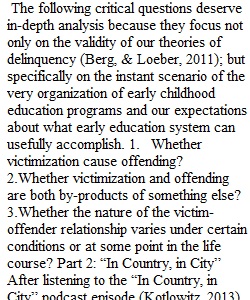


Q Part 1 of M3 Reflection Journal is based on what you have learned in M3 Module Material: Victim-offender overlap, and What Works in crime prevention. Formulate three critical questions about the things you have learned there: • Critical Question 1: • Critical Question 2: • Critical Question 3: Part 2. Listen to Act 2 of This American Life episode about the similarity of experiences between inner-city kids and war veterans (23-minute audio). In Country, in City https://www.thisamericanlife.org/484/doppelgangers/act-two-0 (Links to an external site.) After listening to this podcast episode, answer the following questions in a 2-3 paragraph essay: • What do you think about the effects of a neighborhood on kids? • Is it really disorganization or would you say there are more serious problems running deep in poor inner-city neighborhoods? • Is crime more about communities where we live than individual characteristics? You can write your essay in Microsoft Word and attach the file to this submission. Clearly indicate Part 1 and Part 2 of your answer. (Only you and the instructor/TA will be able to see journal entries. Reflection essays are graded based on how thoughtful they are and how well they incorporate and synthesize the module material.) Due on the last day of Module 3
View Related Questions